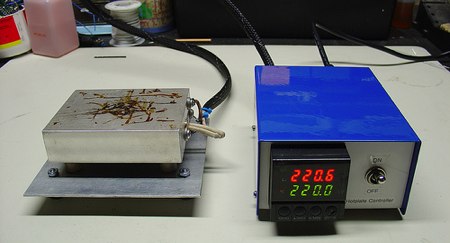[mightyohm] put together a nice piece of lab kit. It’s a PID controlled hot plate. The plate is capable of reaching 500F, hot enough to do SMD reflow soldering. The large chunk of metal has a hole drilled through the center to contain a cartridge heater. A thermocouple is used to monitor the temperature of the plate. Ceramic standoffs separate the plate from the rest of the device, but he still needs to come up with a way to stop the radiant heating. The control box houses the surplus PID controller along with the power switch and solid state relay (SSR).
PID SMD Reflow Hot Plate
15 Comments
- by: Eliot

















My guess is that the base plate does not only heat up by radiant heating, but also by conduction thru air. To lower the radiant heating, one might polish that base plate (I guess), but maybe there are better materials to isolate the hot plate. I’d love to make a suggestion, but I don’t know any properties from any materials.
I’m guessing that the time to heat up that block (even with a 500W heater and a PID controller) does take a minute and might be quicker by using a thinner block. So is there a specific reason why the hot plate is so massive?
Seems like a very handy tool, I might make my own one day.
“So is there a specific reason why the hot plate is so massive?”
So it heats evenly?
Not sure if aluminum foil is reflective in IR but I’d try adding a sheet of nice shiny aluminum foil (shiny side up) between the hot plate and the base plate to act as radiant barrier.
A Pizza/Toaster oven with quartz heating elements can be altered for smd reflow(!) use, which calls for a rigid temperature curve (take a look in a semiconductors datasheet). This is just a hot enough plate to melt solder tin.
I wonder how hot is “too hot?” The reason for the mass would be fewer temperature fluctuations. I’m assuming he’s using aluminum for the block. The article isn’t very detailed (what model PID and sensor is he using?).
A nice, thick sheet of garolite, teflon, or several layers of stripped circuit boards would help with the heat, or even be a better base, but would significantly add cost.
I wonder where he got the heater? As one who works with hot melt adhesives daily, I’ve found that some heaters can be very expensive.
Why not just get a piece of glass wool (NOT fiberglass insulation, though this will probably work) or a piece of (moderately thin) refractory material (this could also be made: google ‘diy refractory lining’, etc)
Interesting idea, though I’d prefer the oven approach.. you’d probably get more even heating and this would allow for pre-heating the board.. most components follow a JEDEC standard for soldiering (at least SMT stuff) which seems to be a general guideline than a set of strict rules..
Mcmaster carr has cartridge heaters fairly cheap (~$30 for 500W)
For stopping the radiant heating, I’d look at car / motorcycle exhaust shields, insulation, and wraps. The racing guys have all sorts of useful stuff.
Hey guys, Jeff here (the guy who made the hotplate):
Sorry there isn’t more detail online, eventually I’ll post some more info about the hotplate on my blog at mightyohm.com.
The heater is a cheap 500W cartridge heater from Mcmaster-Carr, it was about $25 as medix stated.
The aluminum baseplate is thick to get even heat distribution and enough thermal mass that the hotplate temp doesn’t crash when I set something on top of it.
The reason this setup is better in some ways than a toaster oven for surface mount soldering is that you can easily watch the solder paste melting and nudge components around with tweezers to get them lined up perfectly. With a stereo microscope this becomes a very powerful tool for doing very tiny components or chips with lots of leads. You could probably do BGAs with this setup if you tried hard enough.
The biggest downside is that it only works with single sided PCBs unless you are creative with the use of spacers and stuff.
I used to do soldering work professionally at a large electronics company and this is what our engineering lab used to solder components as small as 01005’s. That’s half the size of an 0201, smaller than a grain of salt.
Thanks for the suggestions about the refractory materials – my biggest concern is that most of them are possible carcinogens. Aluminum foil may help. One issue I have discovered is that the ceramic standoffs actually conduct heat quite well, better than I had expected, so that may be the primary heat path instead of radiant.
BAM! Radiant heat fixed. http://www.induceramic.com/industrial-ceramic-product/ceramic-foam-insulation
Of course, the heat still has to go somewhere…
I posted some additional information on my blog at:
http://mightyohm.com/blog/2009/01/diy-pid-controlled-soldering-hotplate/
@medix: right on the money. I was about to post recommending wool myself. I’ve seen blacksmiths use the stuff with great results, so a hotplate will be no problem.
use aerogel! cool factor of ten!
http://en.wikipedia.org/wiki/Aerogel
Isn’t a PID action a bit overkill for this?
PI would’ve been enough for temperature
hell, even on-off would be good enough
crazyman – Not really. The temperature needs to be held fairly constant independent of load, and precise temperature control is important to avoid overheating parts.